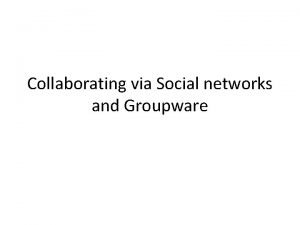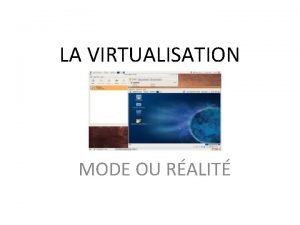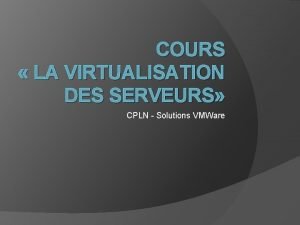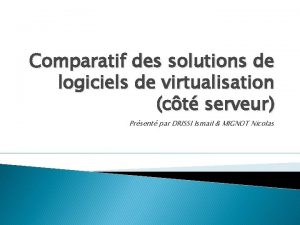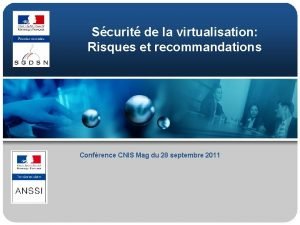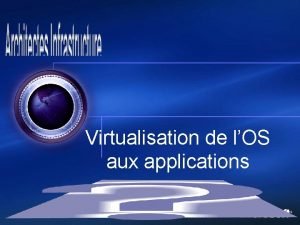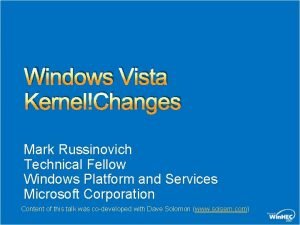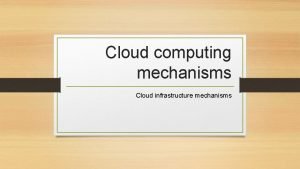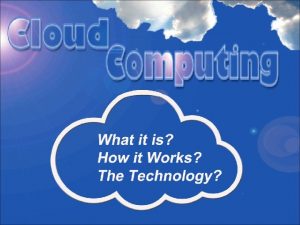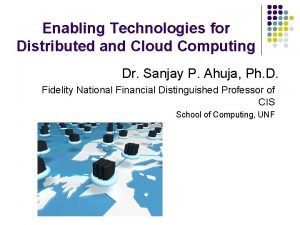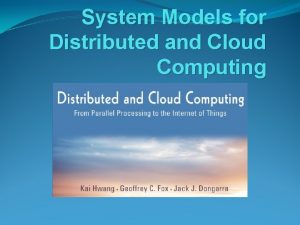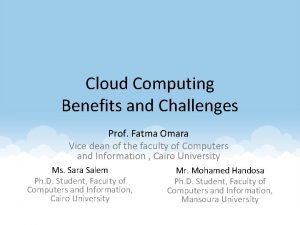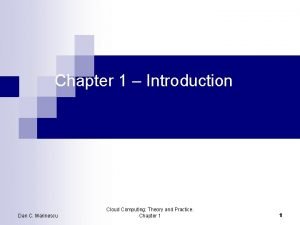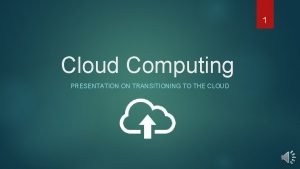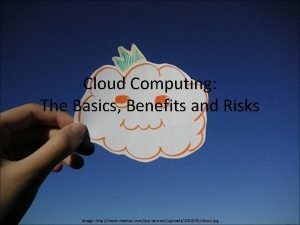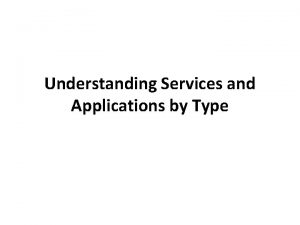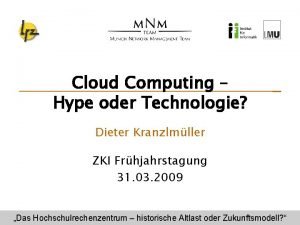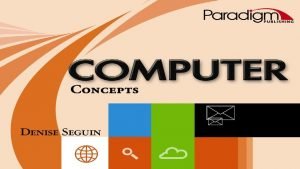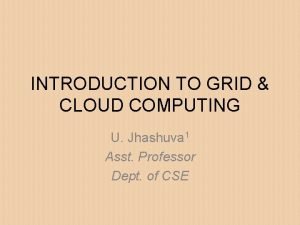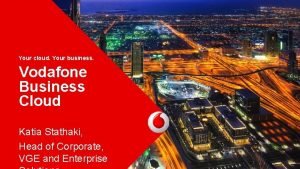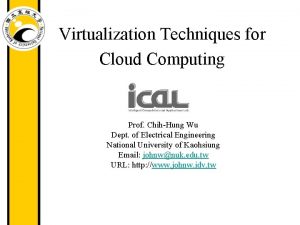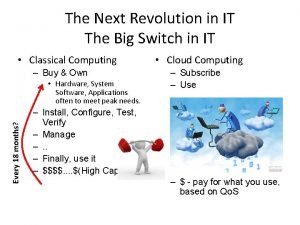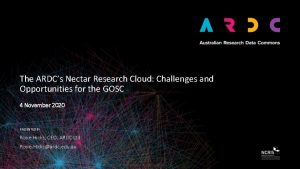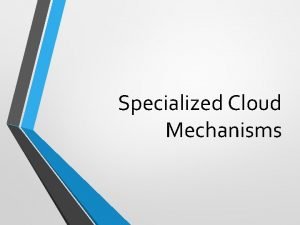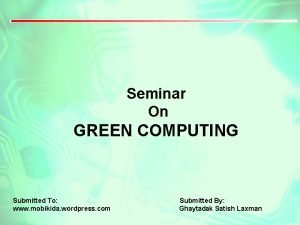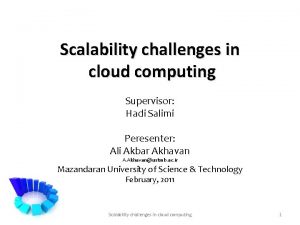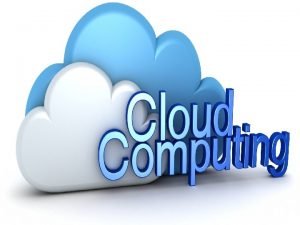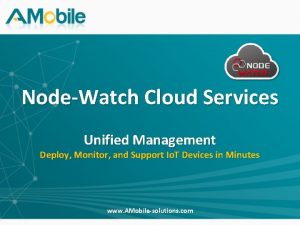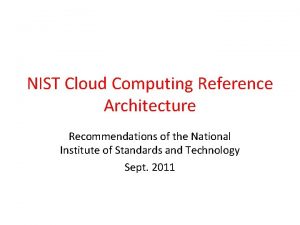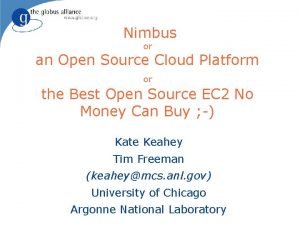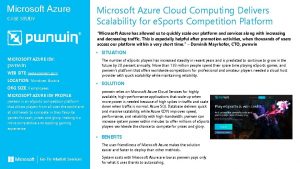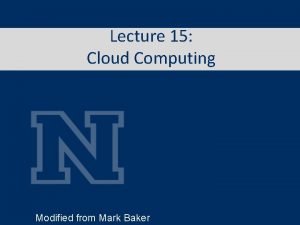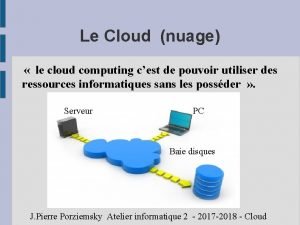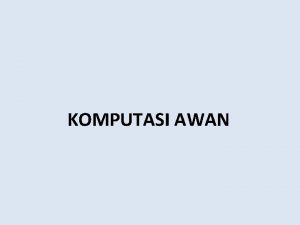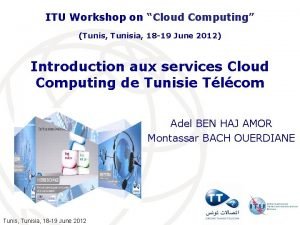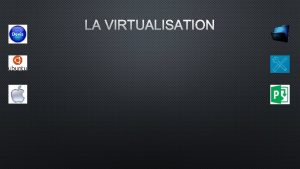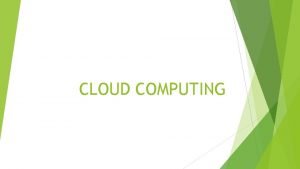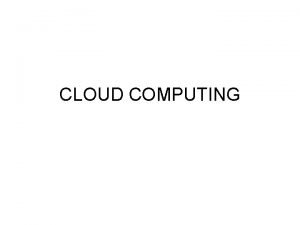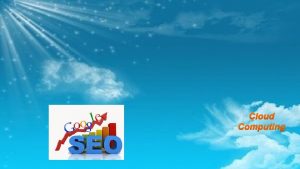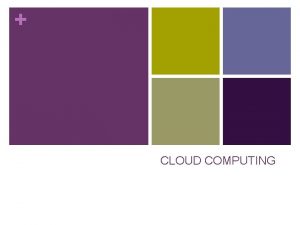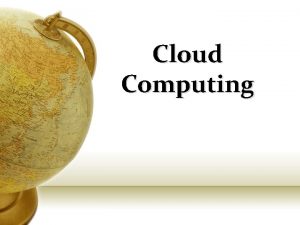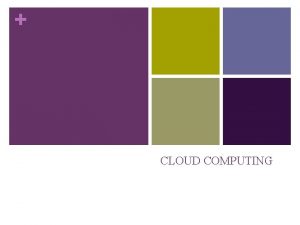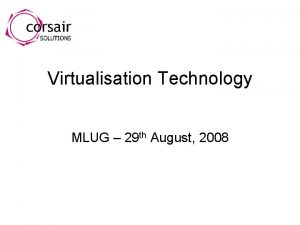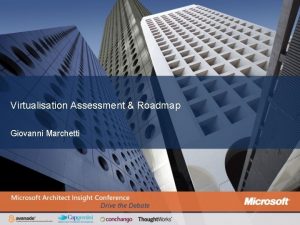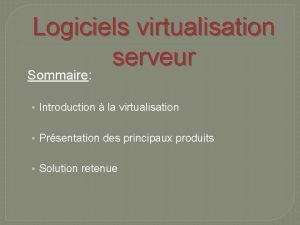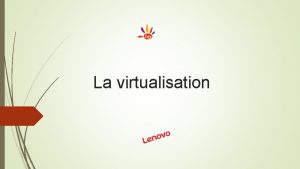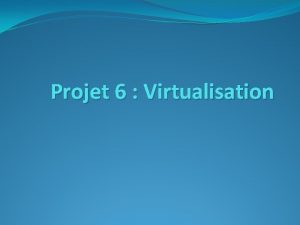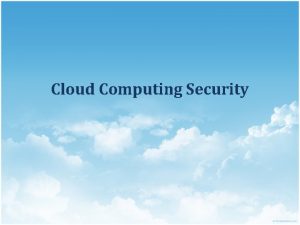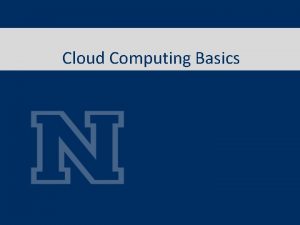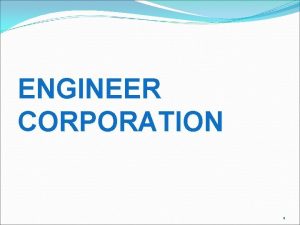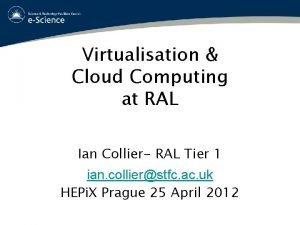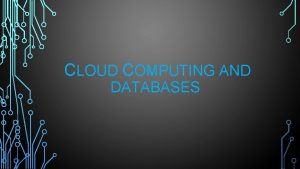Cloud Computing Virtualisation Network Engineer 10 Components and










































- Slides: 42

Cloud Computing Virtualisation Network Engineer

10 Components and functions of virtualised systems (7. 5%) 10. 1 Describe the functions of basic components of virtualised systems. • • host (type 1 and type 2); guest; hardware acceleration extensions (VT-x/AMD-V); sharing of physical resources; • memory; • storage; • compute (CPU). 10. 2 Explain the key differences offered by levels of cloud service. • Infrastructure as a Service (IAAS); • Platform as a Service (PAAS); • Software as a Service (SAAS). 10. 3 Describe the function of virtual desktop infrastructure.

Virtual machines • A virtual machine is a computer file • typically called an image • behaves like an actual computer • It runs as a guest on a host operating system • The VM is sandboxed from the rest of the system • the VM software inside a virtual machine cannot • escape outside of its allocated memory • interfere with the host OS or physical hardware

Virtual machine hardware • Multitasking • A single operating system and several programs running at the same time

Virtual machine hardware • Multi-core or hyper-threading • Multi-core technology • a single processor • symmetrical multiprocessing (SMP) • The OS is run by the first CPU core, additional cores are used by the same operating system • Hyper-threading • simulates an additional processor per CPU core. • Eg a dual-core CPU with Hyper-Threading technology is seen by the OS as if it were a quad-core CPU. • Hyper-Threading technology has the same effect as the multi-core technology.

Virtual machine hardware • Virtualisation • Intel VT (Virtualization Technology) • Creates several virtual machines to run operating systems at the same time • each OS behaves as if is running in a completely independent computer. • With VT you can create several “complete” virtual machines to run full operating systems simultaneously • AMD-V is the equivalent to Intel VT • Both have to be enabled in BIOS

Multiple Virtual machines • Multiple virtual machines can run simultaneously on the same physical computer • For servers, the multiple operating systems run on a hypervisor • Desktop computers run one host operating system to run the guests within the host’s program windows • Each virtual machine provides its own virtual hardware: • • • CPUs Memory Hard drives Network interfaces other devices • The host maps the virtual hardware to the real physical hardware

Multiple Virtual machines • Virtual hardware • Real hardware

Hypervisor hardware support • ESXi (as an example) • RAM 1 TB • Logical processors or cores per motherboard socket 64 • Network cards 10 • Displays 10 • Guest OS 91

Hypervisors • Type 1, native, bare-metal hypervisors • Run directly on the physical hardware • Guests run on top of the hypervisor • Examples are VMware ESXi, Microsoft Hyper-V • Type 2 hosted hypervisors • Run on top of a conventional OS • Examples are VMware workstation, Parallels Desktop for Mac

Hypervisors

Hyper-V is Type 1 • It looks like a type 2! • When you install Hyper-V, Windows appears like a host OS • Hyper-V setup converts the original Windows OS into a root partition puts the hypervisor below • Guests are in child partitions

Prepare for Hyper-V • Open Disk Management • If there are only 2 volumes (C: and G: ) then: • Shrink G to ~500 GB • In the unallocated space make a new simple volume • 200, 000 MB drive letter V, NTFS, Volume label: Hyper-V • If Hyper-V is not in the list of available programs then: • Run Turn Windows Feature on or off • Tick the check box for Hyper-V, click OK, click Restart Now

Start Hyper-V and create a VM • As administrator • Click New > Virtual Machine • Click Next for custom • Name the VM after the OS, either Win. Server or W 10 Client • Store in V: Virtual. Machines • Click Next • Select Generation 2 • Click Next

VM creation • Use 2048 MB of memory for a Win. Server • Use 1024 MB of memory for a W 10 Client • Click Next • Connect to to the default switch • Click Next • Create a VHDX of 100 GB for Win. Server, 50 GB for W 10 Client • Use the default location (on the V: drive) • Click Next • Install the OS later and click Next • Click Finish

Install an OS on Hyper-V • Click Settings for the VM (eg Win 10 Client) • Click on SCSI Controller • Add a DVD drive: Click on Image file and browse to location of Windows. iso (ISO (Z; ) • Click Open, then Apply and OK • Start the VM • Windows Setup will boot

W 10 Client Settings • UK • Customise and turn off all options • Create a user account Apprentice • Password Apprentice 01 • Password hint Apprentice. XX • Not now Cortana • Not now Updates • No to network discovery

Export a VM • Using Hyper-V Manager • In Hyper-V Manager, right-click the virtual machine and select Export. • Choose where to store the exported files, and click Export. • When the export is done, you can see all exported files under the export location. • Using Power. Shell • Open a session as Administrator and run a command like the following, after replacing <vm name> and <path>: • Export-VM -Name <vm name> -Path <path>

Import a VM • Importing depends on where you saved the export files • See : https: //docs. microsoft. com/en-us/windows-server/virtualization/hyper-v/deploy/export-and-importvirtual-machines for details

Usage • Use the VM Windows Client for all the practicals • If you need to revert to an original state you can delete the VM and import the original exported version

Server 2012 • Repeat the installation for Server 2012 • You will now have 2 Virtual Machines which can communicate via the virtual switch • Configure networking • Properties of local area connection • Properties of IPV 4 • Set static address and subnet mask (eg 192. 168. 1. 100)

Configure Server 2012 • Add roles • Select Active Directory Domain roles • Install it • Run dcpromo. exe • Create a new domain • You may need to set a stronger password eg Passw 0 rd 123456 • Use local users in control panel • Use your name eg me. co. uk

Configure Server 2012 • Set the functional level to Windows Server 2012 • Select DNS server • Click yes to continue • Accept default file settings • Use the same strong password • Click next to install • Restart

Configure Server 2012 • Add roles • DHCP • File services • Print services • Research and apply these yourselves

Configure Server 2012 • Add a user – John Doe etc • Assign permissions • Allocate file space to the users (folder structure) • Login to the domain (from your Client VM) and map the allocated network drive • Congratulations, you have created a virtual data centre

Configure Server 2012 • Add a user – John Doe etc • Assign permissions • Allocate file space to the users (folder structure) • Login to the domain (from your Client VM) and map the allocated network drive • Congratulations, you have created a virtual data centre

Characteristics of cloud computing • On-demand self-service • provisioning or de-provisioning of computing resources as needed in an automated fashion without human intervention • Ubiquitous network access • computing facilities can be accessed from anywhere over the network using any sort of thin or thick client • Resource pooling • resources (physical or virtual) can be dynamically assigned, reassigned or de-allocated • Rapid elasticity • resources can be elastically provisioned or released according to demand • Measured service • pay only for what is used

Amazon AWS • 10 minute tutorial • Launch a Windows Virtual Machine • https: //aws. amazon. com/getting-started/tutorials/launch-windows-vm/ • (don’t create an account, just read the tutorial)

Benefits of cloud computing • Increased operational efficiency through cost-effective use of expensive infrastructure • Drives up economies of scale through shared resourcing • Rapid and agile deployment of customer environments or applications • Improved service quality and accelerated delivery through standardisation • Promotes green computing by maximizing efficient use of shared resources, lowering energy consumption

Private Cloud • The cloud infrastructure is operated solely for an organization. It may be managed by the organization or a third party and may exist on premise or off premise • Computing resources are behind the company firewall

Public Cloud • The cloud infrastructure is made available to the general public or a large industry group and is owned by an organization selling cloud services

Cloud Infrastructure as a Service (Iaa. S) • Provides processing, storage and networks • The consumer is able to deploy and run arbitrary software, which can include operating systems and applications • The consumer does not manage or control the underlying cloud infrastructure, but has control over • • operating systems storage deployed applications selected networking components (e. g. , host firewalls) • Examples are: • Microsoft Azure • Amazon Web Services • Google Cloud

Cloud Infrastructure as a Service (Iaa. S)

Cloud Platform as a Service (Paa. S) • The consumer deploys onto the cloud infrastructure consumer-created or acquired applications created using programming languages and tools supported by the provider • The consumer does not manage or control the underlying cloud infrastructure but has control over the deployed applications • Examples are: • server space for web pages such as Rackspace or Go. Daddy • Google App engine

Cloud Platform as a Service (Paa. S)

Cloud Software as a Service (Saas) • The ability to use the provider’s applications running on a cloud infrastructure • The applications are accessible from various client devices through a thin client interface, such as a Web browser • The consumer does not manage or control the underlying cloud infrastructure including network, servers, operating systems, storage, or even individual application capabilities • Examples are: Google Docs, Office 365, Gmail, Dropbox, Slack

Cloud Software as a Service (Saas)

Anything as a Service (Xaas) • Covers the delivery of anything as a service • • • Iaas (Infrastructure as a service) Paas (Platform as a service) Saa. S (Software as a a service) Saa. S (Storage as a service – confusion!) DBaa. S – database as a service Maa. S – malware as a service DRaa. S – disaster recovery as a service Caa. S – communications as a service Naa. S – network as a service

Virtual desktop infrastructure (VDI) • Virtualization technology that hosts a desktop operating system on a centralized server in a data centre • There are two main approaches to VDI: • persistent VDI provides each user with his or her own desktop image, which can be customized and saved for future use • non-persistent VDI provides a pool of uniform desktops that users can access when needed • non-persistent desktops revert to their original state each time the user logs out • The desktop image is delivered over a network to an endpoint device, which allows the user to interact with the OS and its applications as if they were running locally • The endpoint may be a traditional PC, thin client, tablet or even a mobile device • Little actual computing takes place at the endpoint • IT departments may be able to extend the lifespan of otherwise obsolete PCs • organizations can buy cheaper, less powerful machines

Virtual desktop infrastructure (VDI) • Security • all data lives in the data centre, not on the endpoint • Malware protection applied at the data centre • Non-persistent VDI • IT has a minimal number of master images to maintain and secure simpler than managing desktop for each user • Ability to more easily support remote and mobile workers • A Windows desktop and applications can be hosted on other OS (OSX, Chrome, Linux, Android)

Virtual desktop infrastructure (VDI) • Drawbacks • Data centre storage requirements • Network connectivity • Requires high bandwidth for processor or graphics intensive software • Licensing complexity

Summary 10. 1 Describe the functions of basic components of virtualised systems • • host (type 1 and type 2); guest; hardware acceleration extensions (VT-x/AMD-V); sharing of physical resources; • memory; • storage; • compute (CPU). 10. 2 Explain the key differences offered by levels of cloud service. • Infrastructure as a Service (IAAS); • Platform as a Service (PAAS); • Software as a Service (SAAS). 10. 3 Describe the function of virtual desktop infrastructure.
 Collaborating via social networks in cloud computing
Collaborating via social networks in cloud computing Which computing refers to applications and services
Which computing refers to applications and services La virtualisation définition
La virtualisation définition Esxi memory ballooning
Esxi memory ballooning Comparatif hyperviseur
Comparatif hyperviseur Virtualisation
Virtualisation Astu linux command
Astu linux command Local session manager
Local session manager Network centric computing
Network centric computing Ready made environment in cloud computing
Ready made environment in cloud computing Cloud computing network topology
Cloud computing network topology Intel to some cpu chips
Intel to some cpu chips Palo alto certified network security engineer
Palo alto certified network security engineer Conventional computing and intelligent computing
Conventional computing and intelligent computing Virtualization tools and mechanisms
Virtualization tools and mechanisms Explain system models for distributed and cloud computing
Explain system models for distributed and cloud computing Mainframe vs cloud
Mainframe vs cloud Cloud computing theory and practice
Cloud computing theory and practice Internet and cloud computing presentation
Internet and cloud computing presentation Cloud computing benefits and risks
Cloud computing benefits and risks Pods aggregation and silos in cloud computing
Pods aggregation and silos in cloud computing Grid and cloud computing lmu
Grid and cloud computing lmu Cloud computing places the processing and
Cloud computing places the processing and Grid and cloud computing definition
Grid and cloud computing definition Vodafone hybrid hosting solutions
Vodafone hybrid hosting solutions Virtualization techniques in cloud computing
Virtualization techniques in cloud computing Altostratus definition
Altostratus definition Cloud computing reference model
Cloud computing reference model Nectar cloud computing
Nectar cloud computing Pay per use monitor
Pay per use monitor Green cloud computing ppt
Green cloud computing ppt Scalability issues in cloud computing
Scalability issues in cloud computing Elastic computing
Elastic computing Cloud unified management
Cloud unified management What is cloud computing reference architecture
What is cloud computing reference architecture Nimbus cloud computing
Nimbus cloud computing Cloud computing cambridge
Cloud computing cambridge Case study on microsoft azure in cloud computing
Case study on microsoft azure in cloud computing Cloud computing layers
Cloud computing layers Regarder introduction to cloud computing vidéos
Regarder introduction to cloud computing vidéos Sejarah cloud computing
Sejarah cloud computing Petr palas
Petr palas Cloud computing tunisie
Cloud computing tunisie
